Abstract
Atrial and ventricular chronotropic effects of the individual stereoisomers of propranolol, pindolol, metoprolol and penbutolol were studied in conscious dogs with chronic atrio-ventricular (A-V) block. Ventricular beta-adrenoceptor blocking activity was assessed for all drugs against isoprenaline under the same experimental conditions. At low doses, the stereoisomers of propranolol and penbutolol decreased atrial rate, whereas those of pindolol and metoprolol produced an increase. At higher doses, all drugs increased atrial rate. All drugs decreased ventricular rate dose-dependently except (+)-pindolol. Relative ventricular beta-blocking potencies of the (-)-isomers of propranolol, pindolol, metoprolol and penbutolol were respectively 38, 21, greater than 43 and 31 times higher than those of their corresponding (+)-isomers. In addition, beta-blocking potencies of (-)- and (+)-pindolol were respectively 60 and 120 times higher, those of (-)- and (+)-penbutolol 7 and 8 times higher and those of (-)- and (+)-metoprolol 4 and greater than 4 times weaker than those of (-)- and (+)-propranolol. At comparable levels of ventricular beta-adrenoceptor blockade, (-)-pindolol and (-)-metoprolol were more potent in producing ventricular bradycardia than their respective (+)-isomers, whereas (-)- and (+)-propranolol and (-)- and (+)-penbutolol were equiactive. In addition, regardless of which isomer was being studied, the order of ventricular bradycardiac potencies, at comparable levels of beta-adrenoceptor blockade, was metoprolol greater than propranolol greater than penbutolol greater than pindolol.(ABSTRACT TRUNCATED AT 250 WORDS)
Full text
PDF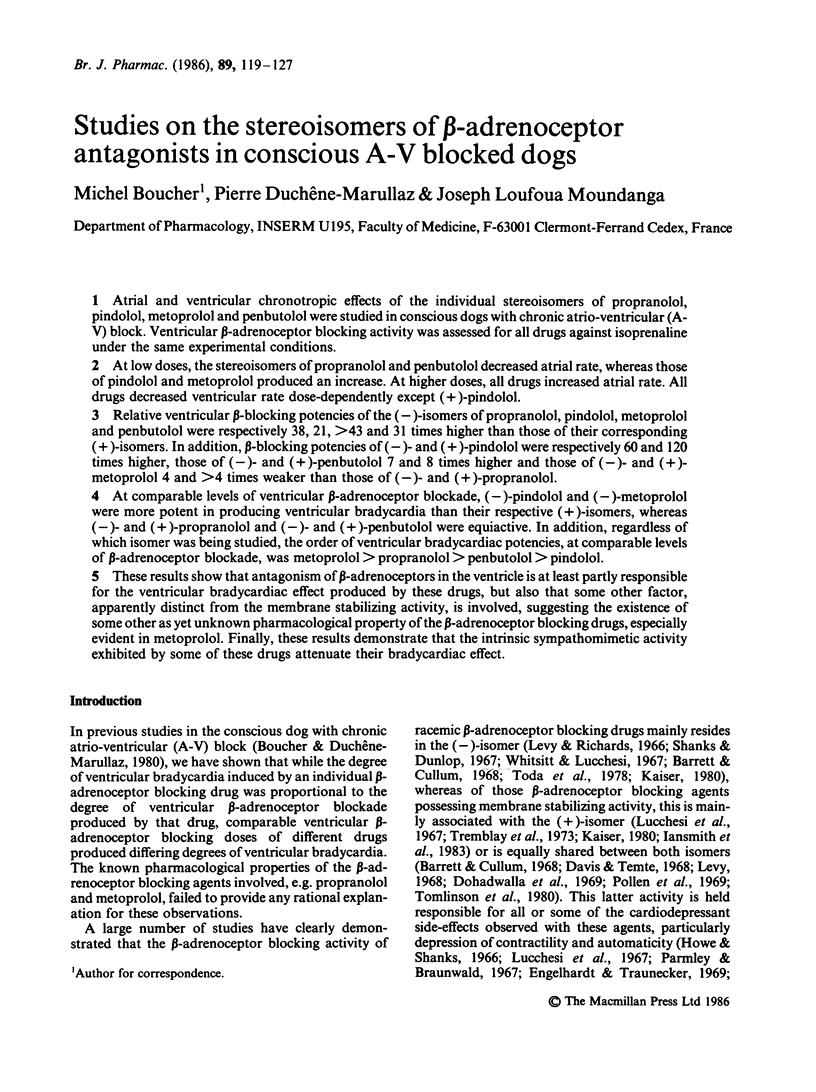
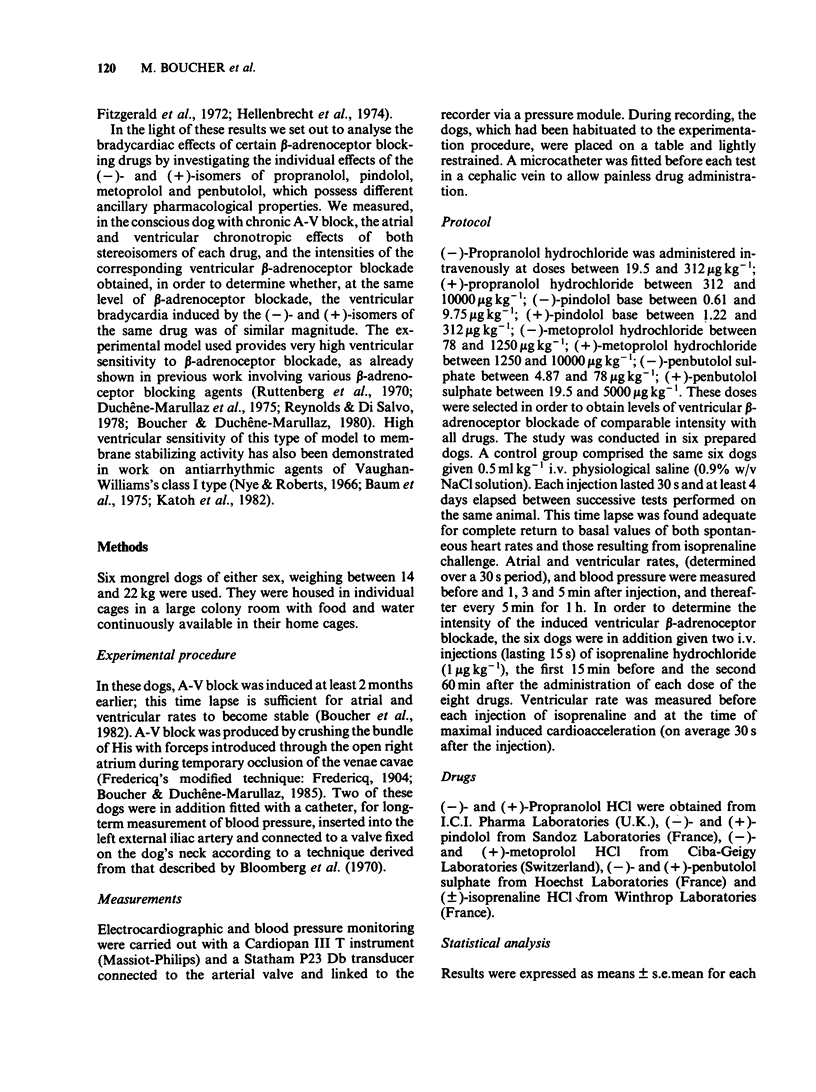
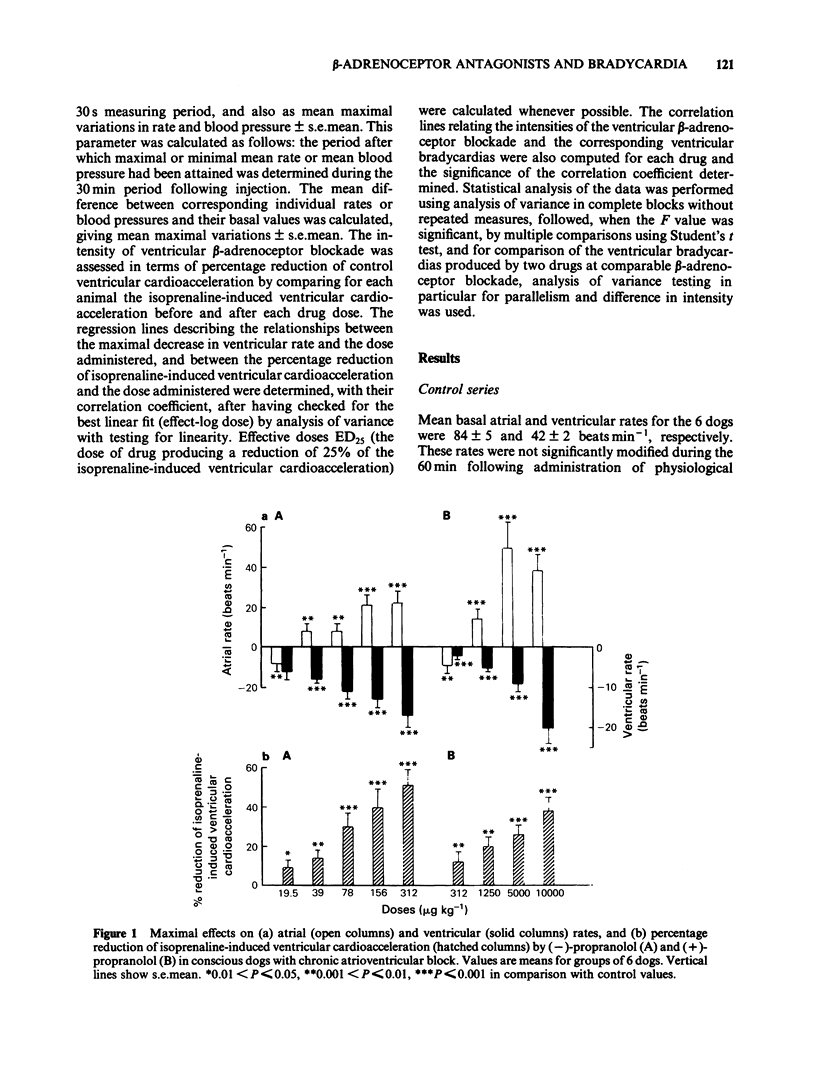
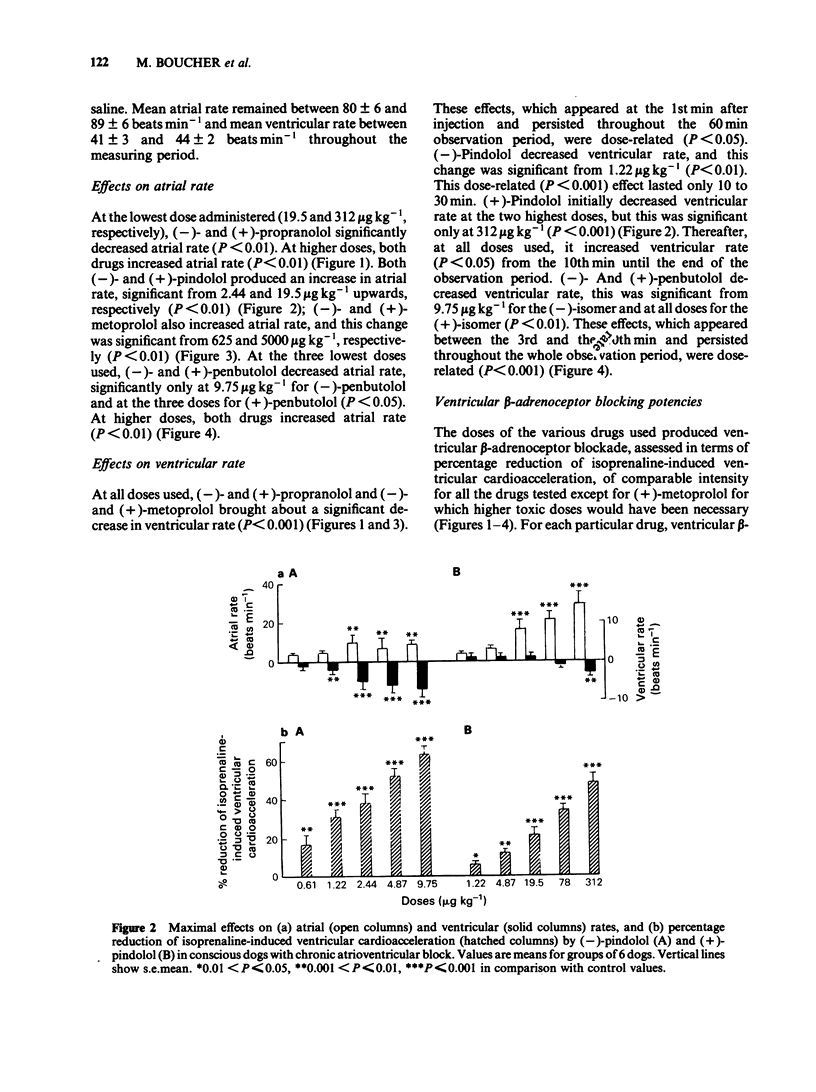
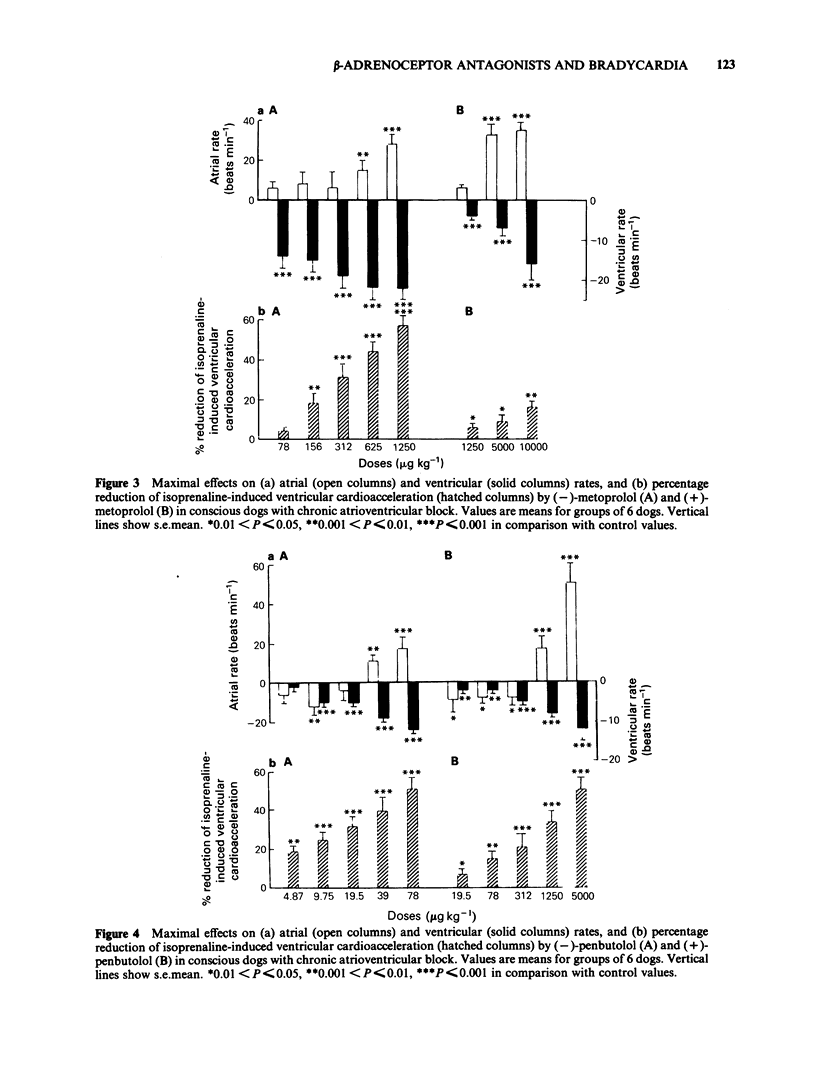


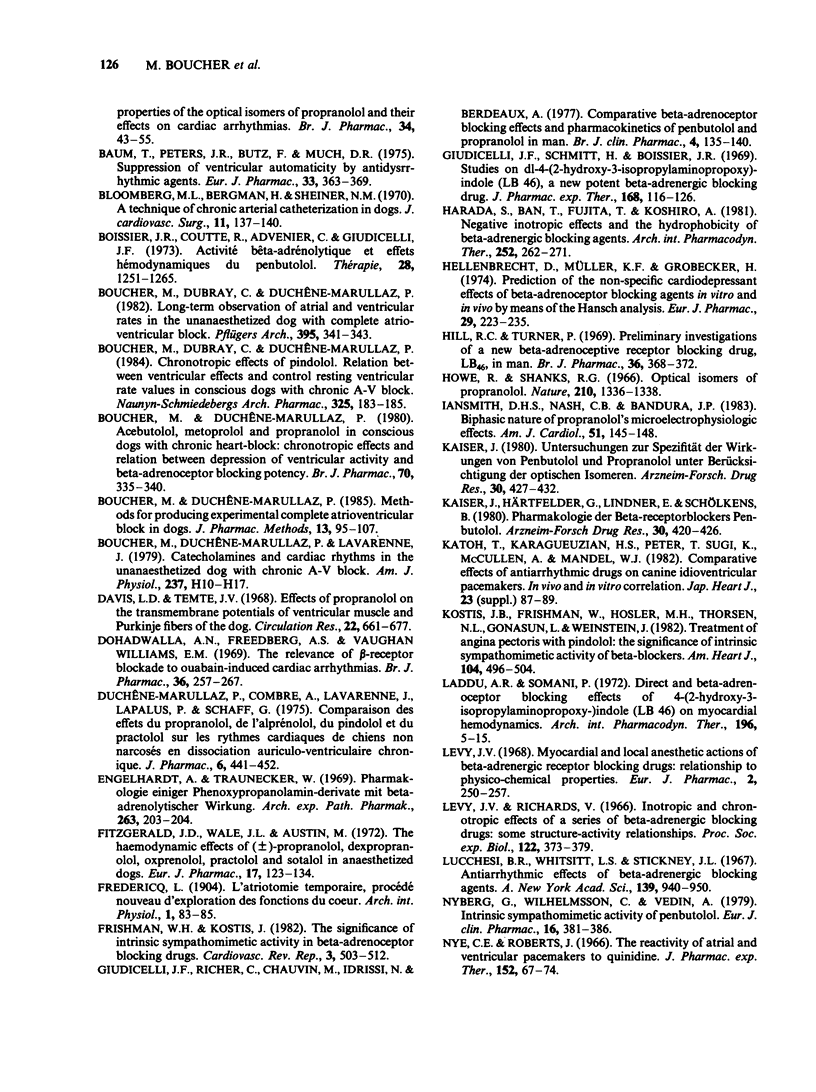

Selected References
These references are in PubMed. This may not be the complete list of references from this article.
- Ablad B., Carlsson E., Ek L. Pharmacological studies of two new cardioselective adrenergic beta-receptor antagonists. Life Sci I. 1973 Feb 1;12(3):107–119. doi: 10.1016/0024-3205(73)90368-8. [DOI] [PubMed] [Google Scholar]
- Aellig W. H. beta-Adrenoceptor blocking activity and duration of action of pindolol and propranolol in healthy volunteers. Br J Clin Pharmacol. 1976 Apr;3(2):251–257. doi: 10.1111/j.1365-2125.1976.tb00600.x. [DOI] [PMC free article] [PubMed] [Google Scholar]
- Barrett A. M., Carter J. Comparative chronotropic activity of beta-adrenoceptive antagonists. Br J Pharmacol. 1970 Nov;40(3):373–381. doi: 10.1111/j.1476-5381.1970.tb10619.x. [DOI] [PMC free article] [PubMed] [Google Scholar]
- Baum T., Peters J. R., Butz F., Much D. R. Suppression of ventricular automaticity by antidysrhythmic agents. Eur J Pharmacol. 1975 Sep-Oct;33(2):363–369. doi: 10.1016/0014-2999(75)90181-8. [DOI] [PubMed] [Google Scholar]
- Boissier J. R., Coutte R., Advenier C., Giudicelli J. F. Activité beta-adrénolytique et effets hémodynamiques du penbutolol. Therapie. 1973 Nov-Dec;28(6):1251–1265. [PubMed] [Google Scholar]
- Boucher M., Dubray C., Duchene-Marullaz P. Long-term observation of atrial and ventricular rates in the unanesthetized dog with complete atrioventricular block. Pflugers Arch. 1982 Dec;395(4):341–343. doi: 10.1007/BF00580799. [DOI] [PubMed] [Google Scholar]
- Boucher M., Dubray C., Duchêne-Marullaz P. Chronotropic effects of pindolol. Relation between ventricular effects and control resting ventricular rate values in conscious dogs with chronic A-V block. Naunyn Schmiedebergs Arch Pharmacol. 1984 Feb;325(2):183–185. doi: 10.1007/BF00506199. [DOI] [PubMed] [Google Scholar]
- Boucher M., Duchene-Marullaz P. Acebutolol, metoprolol and propranolol in conscious dogs with chronic heart-block: chronotropic effects and relation between depression of ventricular activity and beta-adrenoceptor blocking potency. Br J Pharmacol. 1980 Oct;70(2):335–340. doi: 10.1111/j.1476-5381.1980.tb07941.x. [DOI] [PMC free article] [PubMed] [Google Scholar]
- Boucher M., Duchene-Marullaz P. Methods for producing experimental complete atrioventricular block in dogs. J Pharmacol Methods. 1985 Apr;13(2):95–107. doi: 10.1016/0160-5402(85)90053-1. [DOI] [PubMed] [Google Scholar]
- Boucher M., Duchêne-Marullaz P., Lavarenne J. Catecholamines and cardiac rhythms in the unanesthetized dog with chronic AV block. Am J Physiol. 1979 Jul;237(1):H10–H17. doi: 10.1152/ajpheart.1979.237.1.H10. [DOI] [PubMed] [Google Scholar]
- Davis L. D., Temte J. V. Effects of propranolol on the transmembrane potentials of ventricular muscle and Purkinje fibers of the dog. Circ Res. 1968 May;22(5):661–677. doi: 10.1161/01.res.22.5.661. [DOI] [PubMed] [Google Scholar]
- Dohadwalla A. N., Freedberg A. S., Vaughan Williams E. M. The relevance of beta-receptor blockade to ouabain-induced cardiac arrhythmias. Br J Pharmacol. 1969 Jun;36(2):257–267. doi: 10.1111/j.1476-5381.1969.tb09503.x. [DOI] [PMC free article] [PubMed] [Google Scholar]
- Engelhardt A., Traunecker W. Pharmakologie einiger Phenoxypropanolamin-Derivate mit beta-adrenolytischer Wirkung. Naunyn Schmiedebergs Arch Exp Pathol Pharmakol. 1969;263(1):203–204. [PubMed] [Google Scholar]
- Fitzgerald J. D., Wale J. L., Austin M. The haemodynamic effects of ( )-propranolol, dexpropranolol, oxprenolol, practolol and sotalol in anaesthetised dogs. Eur J Pharmacol. 1972 Jan;17(1):123–134. doi: 10.1016/0014-2999(72)90278-6. [DOI] [PubMed] [Google Scholar]
- Giudicelli J. F., Richer C., Chauvin M., Idrissi N., Berdeaux A. Comparative beta-adrenoceptor blocking effects and pharmacokinetics of penbutolol and propranolol in man. Br J Clin Pharmacol. 1977 Apr;4(2):135–140. doi: 10.1111/j.1365-2125.1977.tb00684.x. [DOI] [PMC free article] [PubMed] [Google Scholar]
- Giudicelli J. F., Schmitt H., Boissier J. R. Studies on dl-4-(2-hydroxy-3-isopropylaminopropoxy)-indole A/Giudicelli JF, Schmitt H, Boissier JR: Studies on dl-4-(2-hydroxy-3-isopropylaminopropoxy)-indole (LB 46), a new potent beta adrenergic blocking drug. J Pharmacol Exp Ther. 1969 Jul;168(1):116–126. [PubMed] [Google Scholar]
- Harada S., Ban T., Fujita T., Koshiro A. Negative inotropic effects and the hydrophobicity of beta-adrenergic blocking agents. Arch Int Pharmacodyn Ther. 1981 Aug;252(2):262–271. [PubMed] [Google Scholar]
- Hellenbrecht D., Grobecker H., Müller K. F. Prediction of the non-specific cardiodepressant effects of beta-adrenoceptor blocking agents in vitro and in vivo by means of the Hansch analysis. Eur J Pharmacol. 1974 Dec;29(2):223–225. doi: 10.1016/0014-2999(74)90020-x. [DOI] [PubMed] [Google Scholar]
- Hill R. C., Turner P. Preliminary investigations of a new beta-adrenoceptive receptor blocking drug, LB46, in man. Br J Pharmacol. 1969 Jun;36(2):368–372. doi: 10.1111/j.1476-5381.1969.tb09511.x. [DOI] [PMC free article] [PubMed] [Google Scholar]
- Howe R., Shanks R. G. Optical isomers of propranolol. Nature. 1966 Jun 25;210(5043):1336–1338. doi: 10.1038/2101336a0. [DOI] [PubMed] [Google Scholar]
- Iansmith D. H., Nash C. B., Bandura J. P. Biphasic nature of propranolol's microelectrophysiologic effects. Am J Cardiol. 1983 Jan 1;51(1):145–148. doi: 10.1016/s0002-9149(83)80025-3. [DOI] [PubMed] [Google Scholar]
- Kaiser J., Härtfelder G., Lindner E., Schölkens B. Zur Pharmakologie des beta-rezeptorenblockers penbutolol. Arzneimittelforschung. 1980;30(3):420–427. [PubMed] [Google Scholar]
- Kaiser J. Untersuchungen zur Spezifität der Wirkungen von Penbutolol und Propranolol unter Berücksichtigung der optischen Isomeren. Arzneimittelforschung. 1980;30(3):427–432. [PubMed] [Google Scholar]
- Kostis J. B., Frishman W., Hosler M. H., Thorsen N. L., Gonasun L., Weinstein J. Treatment of angina pectoris with pindolol: the significance of intrinsic sympathomimetic activity of beta blockers. Am Heart J. 1982 Aug;104(2 Pt 2):496–504. doi: 10.1016/0002-8703(82)90146-6. [DOI] [PubMed] [Google Scholar]
- Laddu A. R., Somani P. Direct and beta-adrenoreceptor blocking effects of 4-(2-hydroxy-3-isopropylaminopropoxy)-indole (LB-46) on myocardial hemodynamics. Arch Int Pharmacodyn Ther. 1972 Mar;196(1):5–15. [PubMed] [Google Scholar]
- Levy J. V. Myocardial and local anesthetic actions of beta-adrenergic receptor blocking drugs: relationship to physicochemical properties. Eur J Pharmacol. 1968 Feb;2(4):250–257. doi: 10.1016/0014-2999(68)90074-5. [DOI] [PubMed] [Google Scholar]
- Levy J. V., Richards V. Inotropic and chronotropic effects of a series of beta-adrenergic blocking drugs: some structure-activity relationships. Proc Soc Exp Biol Med. 1966 Jun;122(2):373–379. doi: 10.3181/00379727-122-31138. [DOI] [PubMed] [Google Scholar]
- Lucchesi B. R., Whitsitt L. S., Stickney J. L. Antiarrhythmic effects of beta adrenergic blocking agents. Ann N Y Acad Sci. 1967 Feb 10;139(3):940–951. doi: 10.1111/j.1749-6632.1967.tb41262.x. [DOI] [PubMed] [Google Scholar]
- Nyberg G., Wilhelmsson C., Vedin A. Intrinsic sympathomimetic activity of penbutolol. Eur J Clin Pharmacol. 1979;16(6):381–386. doi: 10.1007/BF00568197. [DOI] [PubMed] [Google Scholar]
- Nye C. E., Roberts J. The reactivity of atrial and ventricular pacemakers to quinidine. J Pharmacol Exp Ther. 1966 Apr;152(1):67–74. [PubMed] [Google Scholar]
- Parmley W. W., Braunwald E. Comparative myocardial depressant and anti-arrhythmic properties of d-propranolol, dl-propranolol and quinidine. J Pharmacol Exp Ther. 1967 Oct;158(1):11–21. [PubMed] [Google Scholar]
- Pollen D. W., Scott A. C., Wallace W. F. A comparison of the direct effects and adrenergic blocking activity of D/L- and D-propranolol on the electrical and mechanical behaviour of isolated frog ventricle. Cardiovasc Res. 1969 Jan;3(1):7–13. doi: 10.1093/cvr/3.1.7. [DOI] [PubMed] [Google Scholar]
- Reynolds R. D., DiSalvo J. Effects of dl-propranolol on atrial and ventricular rates in unanesthetized atrioventricular blocked dogs. J Pharmacol Exp Ther. 1978 May;205(2):374–381. [PubMed] [Google Scholar]
- Robinson J. L., Farr W. C., Grupp G. Atrial rate response to ventricular pacing in the unanesthetized A-V blocked dog. Am J Physiol. 1973 Jan;224(1):40–45. doi: 10.1152/ajplegacy.1973.224.1.40. [DOI] [PubMed] [Google Scholar]
- Shanks R. G., Dunlop D. Effect of propranolol on arrhythmias following coronary artery occlusion in dogs. Cardiovasc Res. 1967 Jan;1(1):34–41. doi: 10.1093/cvr/1.1.34. [DOI] [PubMed] [Google Scholar]
- Sharma P. L., Sapru R. P. Comparative potency of intravenous penbutolol and propranolol in man. Int J Clin Pharmacol Biopharm. 1978 Feb;16(2):83–85. [PubMed] [Google Scholar]
- Toda N., Hayashi S., Hatano Y., Okunishi H., Miyazaki M. Selectivity and steric effects of metoprolol isomers on isolated rabbit atria, arteries and tracheal muscles. J Pharmacol Exp Ther. 1978 Nov;207(2):311–319. [PubMed] [Google Scholar]
- Tomlinson D. R., Haworth S. C., Harmsworth N. J., Ross A. M. The effects of the optical isomers of propranolol on functional refractory period in rat isolated myocardium. J Pharm Pharmacol. 1980 Oct;32(10):693–696. doi: 10.1111/j.2042-7158.1980.tb13040.x. [DOI] [PubMed] [Google Scholar]
- Tremblay G. M., De Champlain J., Nadeau R. A. Effects of d,l-propranolol, d-propranolol, l-propranolol, and sotalol on myocardial contractility and coronary resistance. Can J Physiol Pharmacol. 1973 Feb;51(2):61–67. doi: 10.1139/y73-009. [DOI] [PubMed] [Google Scholar]
- Whitsitt L. S., Lucchesi B. R. The cardiac beta-adrenergic receptor blocking actions of propranolol and its stereoisomers. Life Sci. 1967 May 1;6(9):939–950. doi: 10.1016/0024-3205(67)90080-x. [DOI] [PubMed] [Google Scholar]


